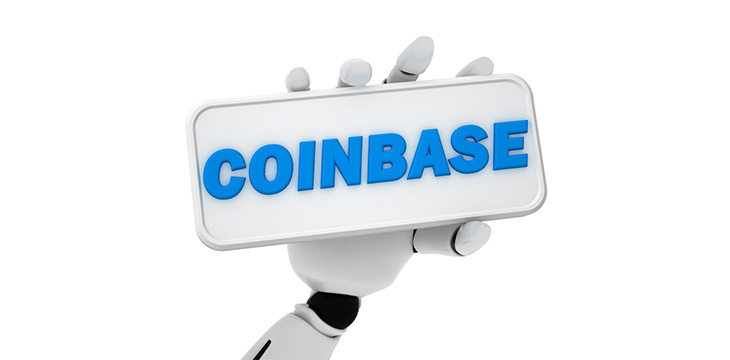Coinbase (NASDAQ: COIN) is turning to artificial intelligence (AI) in a bid to fix the digital asset exchange's habit of going offline whenever the 'crypto' market wobbles.

Coinbase (NASDAQ: COIN) is turning to artificial intelligence (AI) in a bid to fix the digital asset exchange’s habit of going offline whenever the ‘crypto’ market wobbles.
On August 26, Coinbase announced that it has “developed and deployed a machine learning model that predicts spikes in user traffic and automatically scales databases, preventing downtime and increasing platform efficiency.” This model will allegedly allow the exchange to “optimize infrastructure costs by avoiding over-provisioning while ensuring their [our, surely] platforms remain reliable during unpredictable crypto market movements.”
Coinbase is notorious for going offline for extended periods whenever the volatile ‘crypto’ market experiences sudden surges or equally abrupt nosedives in the fiat value of major tokens. Making matters worse, Coinbase sometimes issues announcements of “planned maintenance” even as it simultaneously acknowledges that it’s investigating why its systems are offline.
Like how Coinbase announced on March 11, 2023, that it was “temporarily pausing” conversion of the USDC stablecoin to dollars “over the weekend while banks are closed.” In reality, the California-based Silicon Valley Bank—where USDC issuer Circle (a Coinbase partner) kept $3.3 billion of its fiat reserves—failed that day following a bank run, leaving Circle with no dollars to convert (until the Federal Reserve—the entity that ‘crypto’ was meant to destroy—bailed it out).
These exchange outages leave Coinbase customers unable to buy or sell their tokens or close out derivative positions, often leading to customers suffering significant financial losses. Even when Coinbase claims its systems have fully recovered, many customers still find themselves unable to withdraw.
Some of the exchange’s more cynical customers—as well as those who merely lob critical comments from the sidelines—have accused the exchange of purposefully pulling the plug to either act as a brake on downward trajectories or allow the exchange to internally cover its butt before customers can do likewise.
It’s worth remembering that Coinbase cut its ‘Website Hosting & Infrastructure’ spending from $440 million in 2022 to $192 million in 2023. Yet it continues to dole out nearly $1 billion annually in stock-based compensation to its execs, who can’t dump these hot potatoes fast enough (766 insider sales worth nearly half a billion dollars and zero buys over the past six months).
Not the best look for a team that allegedly believes its best days are ahead of it, and calls into question Coinbase’s historic tendency to penny-pinch on the infrastructure that’s supposed to preserve its customers’ access to their assets on the exchange.
It’s got electrolytes!
Getting back to the mechanics of the new AI plan, Coinbase claims the traditional method of dealing with traffic surges isn’t “an instant process, starting to scale when traffic is already high is often too late.”
The new AI model is intended to anticipate traffic spikes and scale up resources “before the traffic arrives.” Coinbase claims this new system “served us well” during a recent uptick in activity levels, ratcheting up resources “a few hours before peak traffic.”
The goal was to have at least an hour’s lead time before traffic spikes, but Coinbase found that “by the time our systems begin to notice the start of a spike, it was too late to react.” So, Coinbase designed a longer-term model that considered a number of “external signals,” including fluctuations in the fiat price of BTC, ETH, and other prominent tokens, and tried to predict whether traffic would exceed a particular threshold.
Coinbase cautioned that its new system could still miss a traffic spike, which could result in more downtime. The system could also scale up based on anticipation of a spike that never arrives, which would cost Coinbase money. Splitting the difference, Coinbase designed its system to scale 2x its current level at the sign of a spike, but “de-escalate” if the predicted level fails to exceed the scale target for six hours.
There is a potential flaw in Coinbase’s new model, mainly, the tendency of AI models to ‘hallucinate‘ and make decisions based on erroneous information. What if Coinbase’s system confuses rising traffic with falling traffic? And what if it assumes nothing is amiss, possibly due to management’s previous public assertions that all is well when it’s most definitely not?
Base hit
아마도 Coinbase는 Ethereum의 레이어 2' 네트워크인 Base 구축에 방해가 되어 거래소 인프라가 지연되었을 수 있습니다. Base는 출시된 지 1년 조금 넘었지만 Coinbase의 많은 시간, 관심 및 (분명히) 리소스를 빠르게 차지했습니다.
GrowThePie의 통계에 따르면 Base의 일일 활성 사용자 수는 8월 24일 처음으로 100만 명을 돌파했습니다. Base의 주간 활성 사용자 수는 460만 명을 넘어 약 120만 명으로 2위인 Arbitrum을 압도합니다.
이 활동의 대부분은 거의
The above is the detailed content of Coinbase (NASDAQ: COIN) Turns to AI to Fix Its Offline Habit. For more information, please follow other related articles on the PHP Chinese website!




